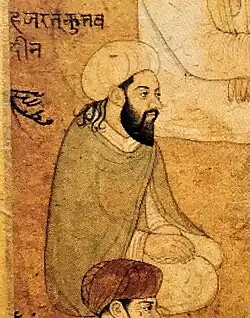Panj peer

Panj peer (or panj pīr), meaning the five saints in Persian, were Islamic saints who overlapped in late 12th and early 13th centuries in northwestern India. There was also a similar tradition in Rajasthan, known as Panch Pir, whose quintet were subsequently Rajputized.[1]
Sufis
The Islamic panj pirs were:
| No. | Name | Portrait | Lifespan | Region | Reference(s) |
|---|---|---|---|---|---|
| 1. | Mu'in al-Din Chishti | 
|
1143 – 1236 | Ajmer, Rajasthan | [2][3][note 1] |
| 2. | Qutb al-Din Bakhtiyar Kaki | 
|
1173 – 1235 | Mehrauli, Delhi | [3] |
| 3. | Farid al-Din Ganjshakar | 
|
1179 – 1266 | Pakpattan, Punjab | [3] |
| 4. | Baha al-Din Zakariya | 1182 – 1268 | Multan, Punjab | [3] | |
| 5. | Lal Shahbaz Qalandar | 1177 – 1274 | Sehwan, Sindh | [4] |
The above Sufi saints are mentioned (alongside Nizam al-Din Awliya) in the great love-epic of the Sufi poet sayyid Waris Shah, Heer Ranjha, which opens with an invocation to them.
Rajasthan
The concept of panch pir in Rajasthan likely derived from the earlier concept of punch pir in Punjab and other parts of northwestern India.[1] Which figures were included in the panch pir quintet varied by region, however Goga was usually always included amongst the five.[1] In Rajasthan, there panch pir were:[1]
| No. | Name | Portrait |
|---|---|---|
| 1. | Gogaji | .jpg)
|
| 2. | Pabuji | .jpg)
|
| 3. | Ramdevji | .jpg)
|
| 4. | Harabhuji | .jpg)
|
| 5. | Mallinathji[note 2] | .jpg)
|
| Sometimes included: | ||
| Meha Mangali (Mehoji) | .jpg)
| |
These five (or six) figures were folk-deities.[1] Some of these figures were not originally perceived as Rajput heroes and became Rajputized later-on after the 18th century.[1] Originally, figures such as Gogaji, Pabuji, Ramdetji, and Harabhuji were originally associated with the downtrodden sections of society, particularly peasants and pastoralists, but they became appropriated as Rajput figures and their identities were usurped by the ruling-classes.[1]
See also
Notes
References
- ^ a b c d e f g h Shekha, Chander (2022). "A historical and legendary profile of Gogaji, a popular folk deity of medieval Rajasthan" (PDF). International Journal of Applied Research. 8 (12): 141–145.
- ^ Sudarshana Srinivasan (22 August 2015). "An afternoon with the saints". The Hindu (newspaper). Retrieved 3 December 2021.
- ^ a b c d "Sufis and the Spread of Islam". Story of Pakistan website. 28 April 2012. Archived from the original on 6 August 2014. Retrieved 3 December 2021.
- ^ Masood Lohar (5 October 2004). "Saint revered by people of all religions". Dawn (newspaper). Retrieved 4 December 2021.